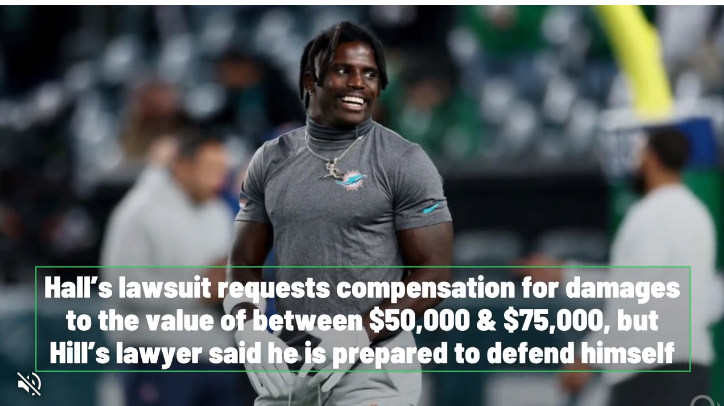Dolphins Face Tough Offseason Decisions Amid Salary Cap Crunch
The Miami Dolphins enter the offseason approximately $12 million over the salary cap, with significant roster needs—at least seven starters and 10 key backups. Some players are clear-cut keepers, including tight end Jonnu Smith, who had an outstanding season and will carry a $4.6 million cap hit in 2025. Others, such as De’Von Achane, Malik Washington, Patrick Paul, and Jaylen Wright, remain on affordable rookie contracts and are expected to stay.
Quarterback Tua Tagovailoa is also a lock to return. He tied with Josh Allen for eighth in the NFL in passer rating and, due to his hefty contract, remains Miami’s best option under center.
However, for other offensive players, the Dolphins must weigh the pros and cons of keeping or moving on.
1) WR Tyreek Hill
Why keep him? Despite a drop in production from 119 receptions (2023) to 81 (2024) and a decline in yards from 1,799 to 959, Hill remains the most dangerous weapon on offense. Financially, trading him before June 1 would result in a higher cap hit ($28.3 million) than keeping him ($27.7 million). His 2025 salary is fully guaranteed, and his trade value isn’t high enough to justify parting ways. Hill’s camp has expressed a desire to compete, with his past frustration-driven remarks not necessarily signaling an exit.
Why let him go? A post-June 1 trade would reduce Miami’s 2025 cap hit from $27.7 million to $12.7 million. Additionally, Miami could make a statement by moving on from a player who openly expressed dissatisfaction and left the field in the season finale.
Verdict: Keep him and ensure he gets more targets. Trading him only makes sense after June 1 if Miami secures a top-tier guard or safety alongside valuable draft capital.
2) WR Jaylen Waddle
Why keep him? Waddle is crucial for Miami’s post-Hill future. Financially, a pre-June 1 trade would increase his cap hit from $8.1 million to $15.1 million, while a post-June 1 trade drops it to $3.8 million. However, any incoming player would also carry a cap hit, minimizing any savings.
Why let him go? If Miami receives a strong offer—such as two picks in the first three rounds—it could be worth considering.
Verdict: Keep him. His contract remains team-friendly, and he’s likely to be Miami’s primary weapon once Hill moves on.
3) LT Terron Armstead
Why keep him? Armstead remains Miami’s best offensive lineman, ranked third among all tackles by PFF. He played 15 games in 2024, his most as a Dolphin, allowing just one sack before struggling in the finale due to a knee issue. Cutting him before June 1 would only reduce his cap hit from $22.1 million to $18.5 million.
Why let him go? If released after June 1, Miami could drop his 2025 cap hit from $22.1 million to $7.8 million. His $13.3 million salary isn’t guaranteed, and his chronic knee problems raise concerns.
Verdict: A pay cut might be the only way to keep him. However, asking him to restructure for a second straight year could push him toward retirement. A parting is more likely.
4) C Aaron Brewer
Why keep him? Brewer performed well, ranking ninth among centers per PFF. His contract is reasonable, with a $6.4 million salary and an $8.1 million cap hit.
Why let him go? Trading him before June 1 would drop his cap hit to $4.4 million, while a post-June 1 trade lowers it to $1.1 million. If Miami drafts a center early, Brewer could become expendable.
Verdict: Keep him unless a top-tier rookie center emerges.
5) RT Austin Jackson
Why keep him? Miami struggled in the run game after his knee injury. GM Chris Grier and coach Mike McDaniel emphasized his importance. His contract includes $5 million in guaranteed salary for 2025, making his return likely.
Why let him go? No clear reason. He’s expected to be healthy by the season opener.
Verdict: Keep him.
6 & 7) Guards Liam Eichenberg & Rob Jones
Why keep them? They provide versatility as backups and could be retained at a low cost.
Why let them go? Both underperformed, ranking 70th (Eichenberg) and 60th (Jones) among 77 qualifying guards. They struggled particularly in run blocking.
Verdict: Retain only at minimum salaries; Miami must upgrade its starters.
8) TE Durham Smythe
Why keep him? He’s reliable.
Why let him go? None of his $3.5 million salary is guaranteed. Cutting him post-June 1 drops his cap hit from $4.8 million to $1.4 million.
Verdict: Move on and save cap space.
9) TE Julian Hill
Why keep him? He showed flashes of strong blocking, and his $1 million cap hit is minimal.
Why let him go? He struggled later in the season, ranking worst among 75 tight ends per PFF.
Verdict: Keep him as a backup but find a better primary blocking TE.
10) FB Alec Ingold
Why keep him? He’s a leader and a strong system fit.
Why let him go? His $3.3 million salary is not guaranteed, and his $4.8 million cap hit drops to $1.2 million if cut after June 1.
Verdict: Try to restructure his deal.
11) RB Raheem Mostert
Why keep him? He’s a year removed from scoring 21 touchdowns and remains affordable at $2.4 million (none guaranteed).
Why let him go? His efficiency dipped to 3.3 yards per carry, and Miami has Jaylen Wright waiting for more touches. His cap hit drops from $4.1 million to $1 million if released.
Verdict: Miami’s decision to give him just one snap in the season finale suggests they’re moving on.
Upcoming Free Agents
Miami’s unrestricted free agents include:
- O-line: Eichenberg, Jones, Kendall Lamm (likely retiring), Isaiah Wynn
- Receivers: Braxton Berrios (likely gone), Anthony Schwartz (restricted), Grant DuBose (exclusive rights free agent)
- Tight Ends: Jack Stoll
- RBs: Jeff Wilson Jr.
The team will need to make tough choices, especially with limited cap space. Defensive evaluations will follow later this week.
Barry Jackson – Miami Herald
